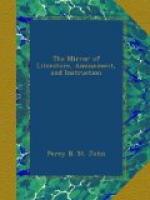And below the effigy runs the following:—
“Hic jacet JOHANNIS GOWER, Armiger, Anglorum Poeta celeberrimus, ac huic sacro Edificio Benefactor, insignis temporibus Edw. III. et Rich. II.”
Here lieth John Gower, esq., a celebrated English poet, also a benefactor to this sacred edifice, in the time of Edward III. and Richard II.
The base of the monument has seven trefoil niches, within as many plain-pointed ones.
The effigy of the poet is placed above, in a recumbent posture, beneath the canopy just described. He is dressed in a gown, originally purple, covering his feet, which rest on the neck of a lion. A coronet of roses adorns his head, which is raised by three folio volumes, labelled on their respective ends, “Vox Clamantis,” “Speculum Meditantis,” and “Confessio Amantis.” Round the neck hangs a collar of SSS. Over the lion, on the side of the monument, are the arms of the deceased, hanging, by the dexter corner, from an ancient French chappeau, bearing his crest. The dress of this effigy has, probably, given rise to the conjectures concerning the rank in life which Gower maintained; but that is too precarious a ground on which to form a decided opinion on such a point.
Gower’s arms are, Argent on a cheveron, azure, three leopard’s heads, Or. Crest. On a chappeau turned up with ermine, a talbot, serjant, proper.
A little eastward of Gower’s monument is part of a pillar, descending from the roof, with a conical base. It is said to be hollow, and has, indeed, somewhat the appearance of a narrow chimney flue.
A biographical outline of Gower may not be unacceptable. He is said by Leland to have descended from a family settled at Sittenham, in Yorkshire. He was liberally educated, and was a member of the Inner Temple; and some have asserted that he became Chief Justice of the Common Pleas; but the most general opinion is that the judge was another person of the same name. It is certain that Gower was a person of considerable weight in his time; even had he not given such ample proofs of his wealth and munificence in rebuilding the conventual church of St. Mary Ouvrie, If he did not actually rebuild the church, as has been asserted, it is well known that he contributed very largely to that undertaking. Perhaps the only fact in detail which it is now possible to ascertain with certainty is, that he founded a chantry in the chapel of St. John, now the vestry.
Gower is supposed to have been born before Chaucer, who flourished in the early part of the fourteenth century, and is believed to have contracted an acquaintance with Gower during his residence in the Middle Temple. Chaucer himself, after his travels on the continent, became a student of the Inner Temple. The contiguity of these inns of court, the similarity of their studies and pursuits, and particularly, as they both possessed the same political bias; Chaucer attaching himself to John of Ghent, Duke of Lancaster, by whom, as well as by the Duchess Blanche, he was greatly esteemed; and Gower giving his influence to Thomas of Woodstock, both uncles to King Richard II.—would naturally produce a considerable degree of friendship and esteem between the two poets.




